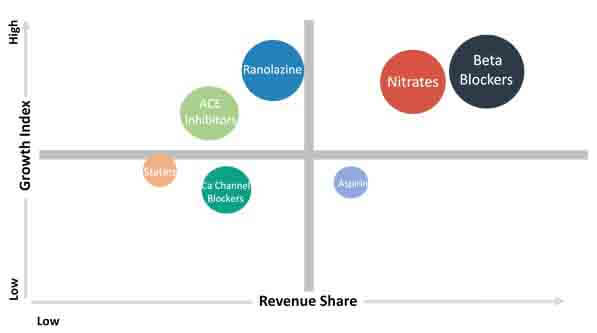Advancement in Medical Therapies has Substantially Improved the Management of Angina Pectoris
Anti-angina drugs are the therapeutics used in the treatment of angina pectoris. The condition is the result of myocardial ischemia which occurs due to an imbalance between myocardial blood supply and oxygen requirement. It is the symptom of coronary heart disease in which the arteries carrying blood to the heart become narrow or are blocked due to atherosclerosis. Several diagnostic tests are performed in order to confirm the condition of angina such as ECG, stress test, echocardiogram, nuclear stress test, chest x-ray, blood tests, coronary angiography, CT scan, cardiac MRI, etc. Anti-angina treatment options include lifestyle changes, medications, angioplasty and stenting, or coronary bypass surgery. The aim of drug therapy is to minimize the symptoms and prevent progression of coronary artery disease. Angina is further classified into stable, unstable and variant angina. Stable angina can be easily managed with medication and lifestyle changes, while unstable angina is complex to treat and needs more attention.
Get Sample Copy of Report @ https://www.persistencemarketresearch.com/samples/22891
Anti-angina Drugs Market Assessment by Drug Type

Nitrates and Beta Blockers Represent the Most Commonly Prescribed Therapeutics of Angina
Nitrates are often used to treat angina as they relax and widen the blood vessels, which allow more blood to flow to the heart muscles. The U.S. FDA has recently approved nitroglycerin sublingual powder “Gonitro” of U.S.-based Espero Pharmaceuticals for acute relief of an angina pectoris attack in 2016. Beta blockers works by blocking the effects of hormone epinephrine (adrenaline) which causes the heart to beat more slowly and with less force, thus reducing the blood pressure. Combining nitrates with β-blockers is most commonly used to block tachycardia and generating synergetic anti-ischaemic effect. Additional and emerging anti-anginal drugs include nicorandil, ivabradine, ranolazine and trimetazidine.
Oral Dosage forms for Angina Management
Oral dosage forms are the most commonly used for the management of angina. This includes normal and extended release tablets & capsules as well as sublingual dosage forms. These drug forms are available as labelled as well as off-labelled medications.
Market Overview of the Anti-Angina Therapeutics
Cardiovascular diseases are the most common cause of deaths globally according to the WHO. Approx. 17.7 million people died from the heart diseases in 2015, representing 31% of all global deaths. High prevalence of ischemic heart disease has been a huge medical and social concern, thus representing a market opportunity for the market players in all the geographies. The trends in the development of anti-angina drugs include the use of synergistic combinations, ongoing clinical trials and other pharmacological developments including novel routes of administration, dosing regimen, etc. Further, clinical trials are being done to find out novel compounds for the treatment of angina capable of improving the quality of patients’ life and minimizing the cost of healthcare. The development of new drugs provides additional therapeutic options in the treatment of stable angina. Increasing competition in the generic version of the medicines is a threat for the market players.
Request Customization of this Report @ https://www.persistencemarketresearch.com/request-customization/22891
Driving and Restraining Factors for Anti-Angina Drugs Market
The global market for anti-angina drugs is driven by the rising number of ischemic heart diseases, rising geriatric population and the adoption of a rich, westernized diet and subsequent increase of smoking, obesity and diabetes. Several new investigational drugs are being tested for the treatment of chronic angina and reducing the side effects of currently marketed drugs. Very few research activities are being conducted specifically to treat angina pectoris. Not much approvals has been granted for the novel compounds in the past few years which also limits the market growth. From the demand side, many of the patients with chest pain remain undiagnosed with the possibility of suffering from angina. Along with this, non-adherence to cardiovascular medications is also been observed greatly among patients suffering from cardiovascular diseases.
Regional Market Outlook
North America is the mature market for anti-angina drugs but have the highest market share. Approximately 9.8 million Americans are estimated to experience angina annually, with 500,000 new cases of angina occurring every year. This is followed by the Western Europe market with EU5 leading the market share owing to the developed medical care facilities and good reimbursement scenario. Asia Pacific region represents a huge market opportunity for the anti-angina drugs market owing to the increasing number of cardiovascular problems and improvising healthcare facilities. Middle East and Africa followed by Eastern Europe represent least market share but a huge market opportunity has been anticipated with the increasing burden of ischemic heart diseases in these regions. Furthermore, statement by Greg Roth, an IHME professor and collaborator of the Global Burden of Disease study also explains the opportunity of these therapeutics in low- and middle-income countries in his statement, “Ischemic heart disease in the leading cause of death in the world, and the vast majority of it occurs outside the high-income world”.
Competition Outlook
Examples of some of the players identified in the global anti-angina drugs market includes Pfizer Inc., MEDA Manufacturing GmbH, Valeant Pharmaceuticals International, Inc., and Gilead Sciences. There are regional as well as international players in the anti-angina drugs market. The companies are looking forward for strengthening their distribution channels to improve their market presence and sales.
| Small Scale Manufacturers/Providers | Medium Scale Manufacturers/Providers | Large Scale Manufacturers/Providers |
|---|---|---|
|
|
|
